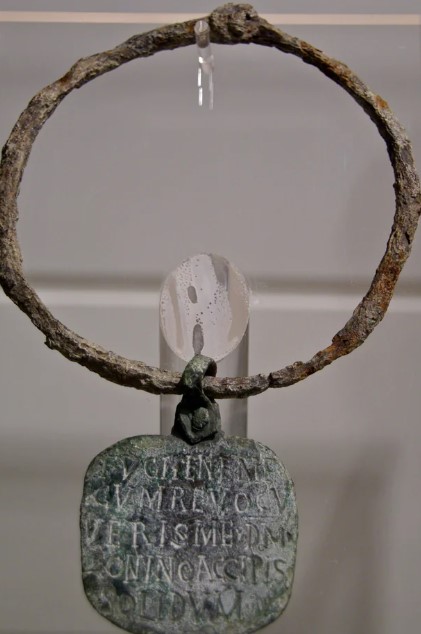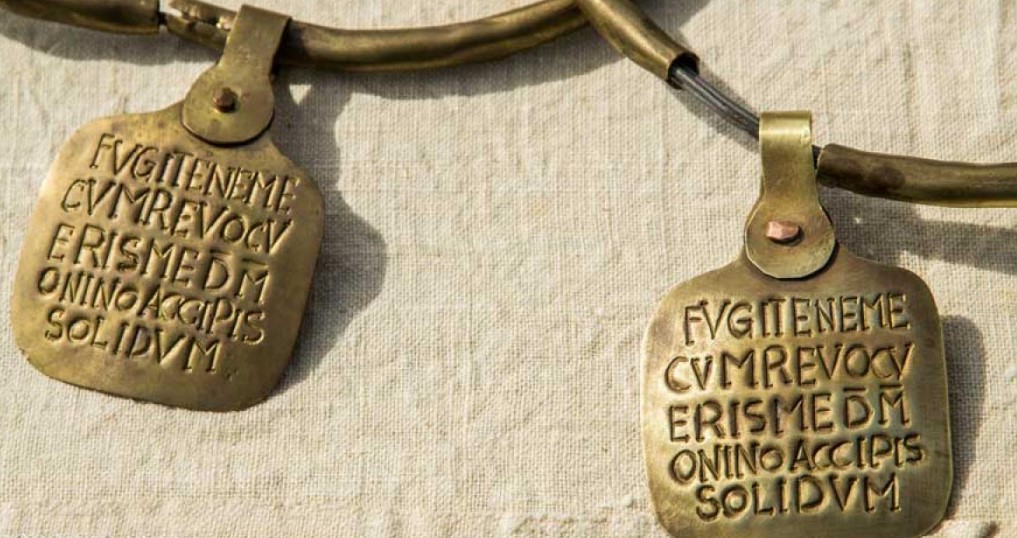Among the countless artifacts from the Roman Empire, few evoke the brutal realities of ancient life as vividly as this rare Roman slave tag. Still attached to its original collar, the tag provides a stark reminder of the dehumanizing conditions endured by enslaved individuals during this era. Follow archeology.dulichvn.net to uncover more mysteries.
Roman Slave Tag into the Life of a Roman Slave
The Inscription’s Chilling Message
The slave tag bears an inscription that reads, “I have fled; seize me and return me to Zoninus for 1 gold coin.” This stark message underscores the perception of slaves as property rather than people, with monetary value assigned to their capture and return. It is a poignant artifact that highlights the grim realities of bondage in ancient Rome.

Dating and Historical Context
Experts estimate that the tag dates back to the 4th or 5th century AD, a time when slavery was a deeply entrenched institution in Roman society. Slaves were integral to the empire’s economy and daily life, serving in roles ranging from domestic servants to laborers in agriculture and construction.
Treatment of Slaves in Rome
This artwork sheds light on the harsh measures used to control slaves. Collars such as this were often used to identify fugitives, ensuring that escape attempts were met with swift recapture. The inscription also serves as a chilling reminder of the lack of autonomy and humanity afforded to enslaved individuals.
See more: The Mystery of the Stone Coffin: Unearthing Medieval Secrets Beneath Leicester
Discovery and Preservation of the Roman Slave Tag
An Artifact of Unclear Origins
The exact location where the tag was discovered remains uncertain, largely due to its passage through private collections before being acquired by a museum. This lack of context poses challenges for researchers aiming to fully understand its historical significance.

Rarity and Significance
Despite the uncertainty surrounding its origin, this slave tag is among the few surviving examples of such artifacts. Its rarity amplifies its importance as a tangible connection to the lives of those who endured enslavement in the Roman Empire.

Preservation Efforts
Now housed in a museum, the tag is carefully preserved as part of a collection dedicated to exploring the complexities of Roman history. By safeguarding such artifacts, historians aim to honor the memory of those who lived under these harsh conditions and ensure their stories are not forgotten.
See more: The Parthenon Frieze A Timeless Masterpiece of Ancient Greece
Understanding the Broader Context of Slavery in Ancient Rome
The Scale of Roman Slavery
Slavery in ancient Rome was widespread, with millions of people enslaved across the empire. Enslaved individuals came from various backgrounds, often captured in wars, born into slavery, or sold due to economic hardships.

The Role of Collars and Tags
Artifacts like this tag were not merely functional; they were a means of asserting control and dehumanizing individuals. Collars with inscriptions acted as constant reminders of a slave’s status and their lack of freedom, serving both as a deterrent to escape and a method of identification.
Legacy and Historical Impact
The systemic use of slavery in Rome had far-reaching implications, influencing societal structures and economic practices. Understanding these dynamics provides valuable insight into the complexities of ancient civilizations and their enduring legacies.
The Slave Tag as a Symbol of Reflection
Humanizing History
While the tag itself is a small, metal artifact, its significance lies in the human story it represents. It serves as a poignant reminder of the individuals who lived, labored, and suffered under Roman rule, offering a glimpse into their struggles and resilience.

Lessons for Modern Society
Artifacts like this compel us to confront uncomfortable truths about the past and reflect on the progress of human rights over centuries. By studying such objects, we gain a deeper understanding of the importance of justice and equality in shaping a more compassionate future.
A Call to Preserve History
The slave tag highlights the necessity of preserving historical artifacts to educate future generations. Museums and researchers play a crucial role in ensuring that these objects remain accessible, fostering dialogue about history and its implications for the present.
Conclusion
The rare Roman slave tag, with its haunting inscription and historical weight, is more than a relic of antiquity. It is a symbol of endurance and a reminder of humanity’s capacity for both cruelty and resilience. By preserving and studying such artifacts, we honor the memory of those who lived through these challenging times and ensure that their stories continue to inform and inspire us today.
As it rests in a museum collection, this small yet significant artifact serves as a window into the harsh realities of slavery in the Roman Empire, reminding us of the importance of empathy, reflection, and progress in understanding our shared history.

CÁC TIN KHÁC
Mary Walton: The Forgotten Inventor Who Helped Clean Up America’s Cities
Tomb of Queen Nefertari in the Valley of the Queens, Egypt
Discover the Hypostyle Hall of the Temple of Hathor at Dendera
Venus de Losange: Unveiling the Mystery of a 20,000-Year-Old Paleolithic Icon